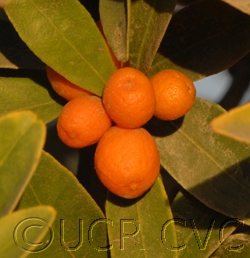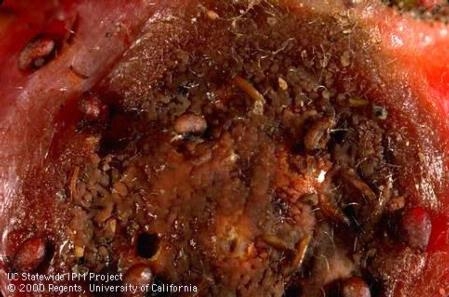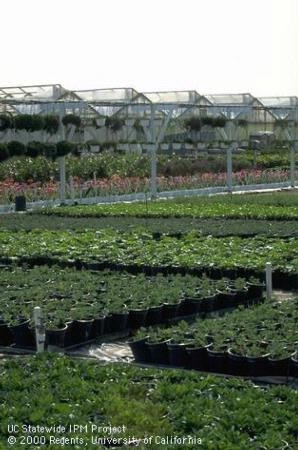
Posts Tagged: nursery production
Reducing the incidence of strawberry anthracnose
Strawberry production growers face many challenges. One such challenge is strawberry anthracnose, which is caused by Colletotrichum acutatum. This plant pathogen is often undetectable on transplants purchased from nurseries for the planting season, but can become very destructive after transplanted into the field.
UCCE’s Oleg Daugovish and collaborators researched this disease and how to best reduce risk and loss. The researchers studied irrigation systems effects on fruit yields, canopy size, and crown tissue infection to determine best management practices.
Their research has recently been published in the American Society for Horticultural Science Journal. You may view the abstract at this site. The full text may also be viewed by following a link on the abstract page. The full article may also be viewed in the UC Cooperative Extension, Ventura County office.
Apium virus Y on celery in coastal California
California farms produce 93% of the celery grown in the United States. The crop thrives in coastal California’s moderate climate. Celery is an important crop in Ventura County with 40% of the state’s acreage farmed here. Valued at over $182 million, it was the second most profitable crop for Ventura County agricultural producers in 2010, which are the most recent statistics available.
Most celery in the field is planted as transplants. Transplants are typically grown under high humidity and high plant density conditions and are subject to seedborne pathogens. The most significant being Septoria apiicola (the causal agent of Septoria late blight) and Pseudomonas syringae pv. apii (the causal agent of bacterial blight). These diseases can be carried from the transplants into the field. As the plants mature, these diseases can cause plants to become unmarketable at a great loss to the growers.
UCCE’s Oleg Daugovish and collaborators researched these pathogens and how to best reduce disease and loss in the field. Over four years, the researchers documented that: seed, seedlings, weeds located in or near fields that harbor the virus can cause the disease in celery. This disease is likely transmitted by aphids, vectoring the virus.
The studies provided practices growers can use to manage this disease. Findings indicated that growers can control the pathogens by managing poison hemlock weed populations, controlling aphids, and planting celery cultivars that are not susceptible to the pathogens.
The interpretive and technical summaries of the research report can be viewed on this page of the USDA’s Agricultural Research Service. The full text can be accessed through the American Phytopathological Society, or at the UCCE office in Ventura County.
Asian Citrus Psyllid host plants
Asian citrus psyllid, has not recently received much attention in the news media. However the pest, and the deadly bacterial disease it can carry, are still of great concern.
The Asian citrus psyllid (ACP) has now been found in eight California counties. Quarantines are in place. The psyllid by itself is not much of a problem; it is its ability to spread the fatal disease that has the potential to devastate both the California citrus industry and backyard citrus throughout the state.
Huanglongbing (HLB) is the name of the disease ACP can carry. Citrus and closely related plants are at risk. The disease is transmitted between plants by the psyllid. The psyllids transmit the disease to healthy plants and trees. After feeding on an infected plant, the ACP will transmit HLB to every other plant it feeds on.
While much outreach has focused on citrus trees, it is important to remember there are other plants that can host both ACP and HLB. This list from the University of Florida provides both the common and Latin plant name for many known hosts. Hosts include: curry leaf, ornamental orange-jasmine, and all the varieties of citrus, including kumquat, mandarin, grapefruit, orange and all of their hybrids.
Please remember to check your citrus and closely related plants regularly for signs of ACP or HLB. General information about this pest disease complex can be found on this section of the CDFA website. For local updates, the Ventura County ACP Task Force is a great source of information.
California Citrus Conference
The 2012 California Citrus Conference will be held October 10-12 in Porterville. This event is organized by the Citrus Research Board (CRB) and will include presentations, demos, and exhibitors.
Topics will include:
- ACP/HLB
- Pests
- Diseases
- Organics
- Irrigation
- Nutrition
Demonstrations and displays will include:
- ACP tracking and mapping
- Spray demonstrations
- Irrigation technologies
- Sensory evaluation lab
For more information please call the CRB at 559.738.0246 or email them.
What is agriculture?
Agriculture is more than food production. The term is used to describe the human cultivation of food, fiber and other products. Many people think of food farming and raising of livestock as the extent of agriculture, but there is much more to this powerful industry.
For approximately 10,000 years agriculture has shaped civilization. And in fact some say that agriculture has made civilization possible. Agricultural progress allowed groups of people the first alternative to a hunter-gatherer lifestyle. Continual improvements in methods and technology took people from subsistence agriculture to production levels. As the production continued to increase fewer people were needed in food and fiber production and were able to focus on other pursuits and careers.
Today agriculture includes foods, fibers, biofuels, biopharmaceuticals, bioplastics, lumber, cut flowers and nursery plants. New agricultural technologies already available and those in the research stage will continue to shape, expand and influence society both locally and globally.
Ventura County has a wide range of agricultural products and production. The size of our local farms are smaller than average; however, our growers efforts combine to form an impressive cumulate result. Using data from the most recent USDA Ag Census Profile, the market value of Ventura County agriculture is ranked 9th statewide and 10th nationwide. When the value of nursery and greenhouse crops are included our county is 4th both state and nationwide. To learn more about the types of agriculture products grown in Ventura County please see the crop reports released by the County of Ventura Agricultural Commissioner.
In addition to crop values, the local agriculture industry branches out and positively impacts our local economy with, transportation/shipping, packing houses, product manufacturing and development, landscape design and maintenance, and much more.





